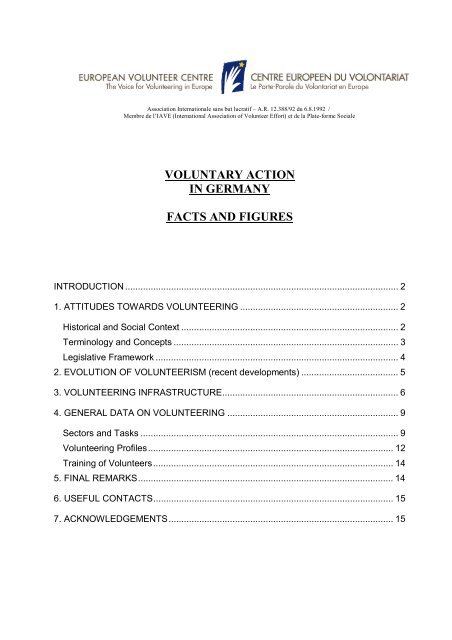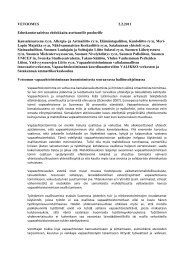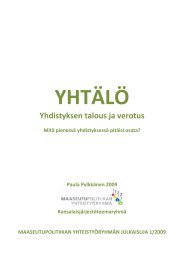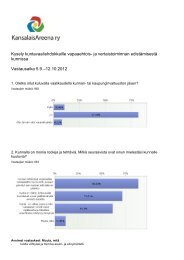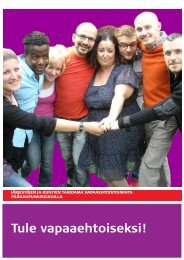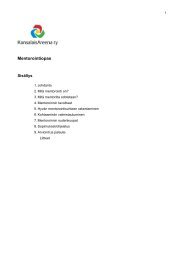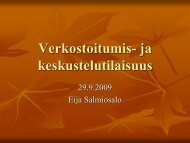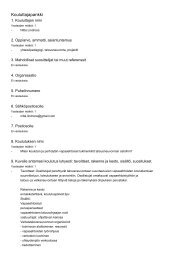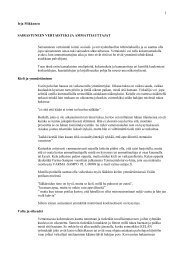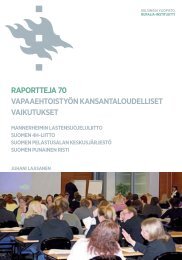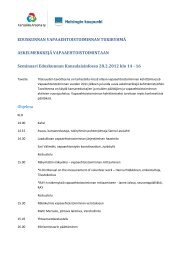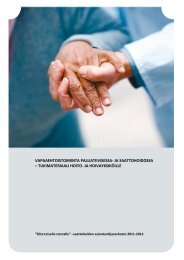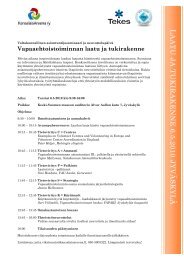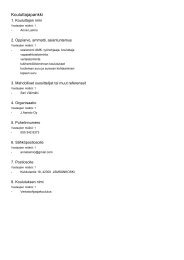voluntary action in germany facts and figures - Kansalaisareena
voluntary action in germany facts and figures - Kansalaisareena
voluntary action in germany facts and figures - Kansalaisareena
You also want an ePaper? Increase the reach of your titles
YUMPU automatically turns print PDFs into web optimized ePapers that Google loves.
Association Internationale sans but lucratif – A.R. 12.388/92 du 6.8.1992 /<br />
Membre de l’IAVE (International Association of Volunteer Effort) et de la Plate-forme Sociale<br />
VOLUNTARY ACTION<br />
IN GERMANY<br />
FACTS AND FIGURES<br />
INTRODUCTION ........................................................................................................... 2<br />
1. ATTITUDES TOWARDS VOLUNTEERING .............................................................. 2<br />
Historical <strong>and</strong> Social Context ..................................................................................... 2<br />
Term<strong>in</strong>ology <strong>and</strong> Concepts ........................................................................................ 3<br />
Legislative Framework ............................................................................................... 4<br />
2. EVOLUTION OF VOLUNTEERISM (recent developments) ...................................... 5<br />
3. VOLUNTEERING INFRASTRUCTURE..................................................................... 6<br />
4. GENERAL DATA ON VOLUNTEERING ................................................................... 9<br />
Sectors <strong>and</strong> Tasks ..................................................................................................... 9<br />
Volunteer<strong>in</strong>g Profiles................................................................................................ 12<br />
Tra<strong>in</strong><strong>in</strong>g of Volunteers.............................................................................................. 14<br />
5. FINAL REMARKS.................................................................................................... 14<br />
6. USEFUL CONTACTS.............................................................................................. 15<br />
7. ACKNOWLEDGEMENTS........................................................................................ 15
INTRODUCTION<br />
This study aims to provide comprehensive <strong>in</strong>formation as well as statistics <strong>and</strong> data on volunteer<strong>in</strong>g <strong>in</strong><br />
Germany. First of all, it gives an overview of the historical, political <strong>and</strong> social framework regard<strong>in</strong>g<br />
volunteer<strong>in</strong>g <strong>in</strong> Germany as well as an approach to the general underst<strong>and</strong><strong>in</strong>g of <strong>and</strong> attitude towards<br />
volunteer<strong>in</strong>g <strong>in</strong> the national context. Secondly, it explores the volunteer<strong>in</strong>g <strong>in</strong>frastructure <strong>and</strong> describes<br />
the actors <strong>in</strong>volved <strong>in</strong> volunteer<strong>in</strong>g at all levels (local, regional <strong>and</strong> national). Furthermore, the study<br />
provides broad data on features of the volunteer population <strong>and</strong> the sectors <strong>in</strong> which volunteers are active.<br />
F<strong>in</strong>ally, conclud<strong>in</strong>g remarks on recent developments of volunteer<strong>in</strong>g <strong>in</strong> Germany are given.<br />
1. ATTITUDES TOWARDS VOLUNTEERING<br />
Historical <strong>and</strong> Social Context<br />
The German concept of welfare is primarily characterized by the “pr<strong>in</strong>ciple of subsidiarity”, that, <strong>in</strong> the<br />
provision of core welfare services, gives preference to non-for-profit organisations (NPO) over public<br />
services. It means that NPOs should act first <strong>and</strong>, if there is no alternative, the state should <strong>in</strong>tervene.<br />
Under the pr<strong>in</strong>ciple of subsidiarity NPOs can claim public f<strong>in</strong>ancial support. Subsidiarity had been fully<br />
developed after the World War II as part of the social legislation <strong>and</strong> created the six “peak” associations<br />
of the welfare sector <strong>in</strong> the Federal Republic of Germany (FRG), which together constitute the Federal<br />
Association of the Voluntary Welfare Organisations (Bundesarbeitsgeme<strong>in</strong>schaft der Freien Wohlfahrtspflege).<br />
1 Almost every NPO <strong>in</strong> Germany is a member of one of the follow<strong>in</strong>g “peak” organisations:<br />
1. Worker’s Welfare Service (Arbeiterwohlfahrt, AWO)<br />
2. German Caritas Association (Caritasverb<strong>and</strong>)<br />
3. Association of Non-affiliated Charities (Deutscher Paritätischer Wohlfahrtsverb<strong>and</strong>, DPWV)<br />
4. German Red Cross (Deutsches Rotes Kreuz, DRK)<br />
5. Welfare Service of the Protestant Church (Diakonisches Werk)<br />
6. Central Welfare Agency of the Jews <strong>in</strong> Germany (Zentrale Wohlfahrtsstelle der Juden <strong>in</strong><br />
Deutschl<strong>and</strong>).<br />
Traditionally, charitable organisations have <strong>in</strong>tegrated volunteers <strong>in</strong> all fields of their activities. However,<br />
volunteer<strong>in</strong>g took place mostly with<strong>in</strong> the framework of the “peak” organisations <strong>and</strong> became more<br />
<strong>and</strong> more marg<strong>in</strong>al due to the professionalisation of social work s<strong>in</strong>ce the 1970s. From 1990 onwards,<br />
there has been a change <strong>in</strong> the underst<strong>and</strong><strong>in</strong>g of what volunteer<strong>in</strong>g means. Many new organisations <strong>and</strong><br />
structures have been founded, <strong>and</strong> at the same time the traditional “peak” organisations have become<br />
more volunteer-oriented aga<strong>in</strong>.<br />
Due to the division of Germany <strong>and</strong> the diverg<strong>in</strong>g political systems <strong>voluntary</strong> commitment developed<br />
differently over four decades. 2 In the former German Democratic Republic (GDR) volunteer<strong>in</strong>g was<br />
1 http://www.freiewohlfahrtspflege.de/english/<strong>in</strong>dex.html<br />
2 H.K. Anheier, E. Priller, Annette Zimmer (2000): Civil society <strong>in</strong> transition: The East German third sector ten<br />
years after unification <strong>in</strong> Münsteraner Diskussionspapiere zum Nonprofit-Sektor, Münster<br />
2
mostly closely related to “mass social organizations” (gesellschaftliche Massenorganisationen). Although<br />
the GDR constitution guaranteed its citizens the freedom to associate, all organizations, such as<br />
political parties, trade unions or <strong>voluntary</strong> organizations, had to accept the supreme authority of the Socialist<br />
Unity Party (Sozialistische E<strong>in</strong>heitspartei Deutschl<strong>and</strong>s, SED). There was no <strong>in</strong>dependence from<br />
state control <strong>and</strong> party ideology. Subsequently, local organizations had to jo<strong>in</strong> one of the “mass social<br />
organizations” such as the Free German Youth (Freie Deutsche Jugend, FDJ) or the cultural association<br />
(Kulturbund). However, these local organisations operated much like non-profit organizations. Government<br />
funds or fees, as well as private donations, supported the organizations. Beside the party ideology<br />
related <strong>voluntary</strong> activities or campaigns, volunteer<strong>in</strong>g also took place under the roof of the Lutheran<br />
Church. The Catholic Church was less represented due to the smaller number of members.<br />
With the breakdown of the lead<strong>in</strong>g SED dur<strong>in</strong>g the transition, traditional organizations were either transformed<br />
<strong>in</strong>to registered associations or changed radically. Some of them just dissolved. Due to the unification<br />
treaty (E<strong>in</strong>igungsvertrag) between the two German states, the area of the former GDR adapted the<br />
exist<strong>in</strong>g legal <strong>and</strong> <strong>in</strong>stitutional system of the FRG on the 3 rd October 1990. Consequently, the social sector<br />
<strong>and</strong> <strong>in</strong> particular the volunteer sector were shaped by the West German “peak” organisations. A significant<br />
amount of public money was transferred to these organisations to set up an <strong>in</strong>frastructure <strong>in</strong> the<br />
new states (neue Bundesländer) accord<strong>in</strong>g to the exist<strong>in</strong>g welfare system <strong>in</strong> Western Germany.<br />
However, there is still a gap <strong>in</strong> scientific research <strong>and</strong> publication about the characteristics of volunteer<strong>in</strong>g<br />
<strong>in</strong> the former GDR. Can the term volunteer<strong>in</strong>g be used <strong>in</strong> the context of the former GDR or was do<br />
we have to talk about compulsory work? In which framework did people engage?<br />
Term<strong>in</strong>ology <strong>and</strong> Concepts<br />
With<strong>in</strong> the current discourse about volunteer<strong>in</strong>g there is a problem with the term<strong>in</strong>ology because different<br />
<strong>and</strong> sometimes compet<strong>in</strong>g concepts are used <strong>in</strong> Germany. The traditional term honorary work (Ehrenamt)<br />
describes <strong>voluntary</strong> work as an engagement <strong>in</strong> formal organisations such as associations, societies<br />
or clubs that is either unpaid or aga<strong>in</strong>st an expense allowance. Literally translated it means a task or an<br />
office assumed on honorary basis, but experts considered this term as too restrictive. Today, activities<br />
may be performed <strong>in</strong> the frame of formal or <strong>in</strong>formal organisations <strong>and</strong> comprise sports <strong>and</strong> recreation,<br />
culture as well as self-help, neighbourhood activities, <strong>and</strong> activities <strong>in</strong> civic <strong>action</strong> groups. In order to<br />
reflect this wide range of activities correspond<strong>in</strong>g to the model of a participatory society, the concepts<br />
<strong>voluntary</strong> <strong>in</strong>volvement (freiwilliges Engagement), volunteer work or volunteer<strong>in</strong>g (Freiwilligenarbeit)<br />
have been <strong>in</strong>troduced. In the f<strong>in</strong>al report of the Federal Parliament’s Study Commission on the Future of<br />
Civic Activities, the term <strong>voluntary</strong> civic activities (bürgerschaftliches Engagement) was used to emphasise<br />
the specific character of all activities assumed voluntarily. Civic <strong>in</strong>volvement is understood as “responsibilities<br />
for others” <strong>and</strong> “becom<strong>in</strong>g active as a member of the community”. 3<br />
So far there is no generally accepted term <strong>in</strong> Germany. In the First National Survey on Volunteer<strong>in</strong>g the<br />
<strong>in</strong>terviewees were asked to choose among five commonly used concepts the one that they would prefer<br />
3 English Summary of the F<strong>in</strong>al Report of the Study Commission of the German Parliament, p.3<br />
3
for the activity they perform. 4 Interest<strong>in</strong>gly, the most popular choice was volunteer work (48%) followed<br />
just at some distance by honorary work (32%). Maybe the term volunteer work reflects the selfconception<br />
<strong>in</strong> a better way than the older term “Ehrenamt”. Although on the national level the term<br />
“Freiwilligenarbeit” seems to put across, on the country level different concepts are still used to describe<br />
almost the same phenomenon, namely activities done on a <strong>voluntary</strong> basis relat<strong>in</strong>g to the society as such.<br />
For example, the Saxon M<strong>in</strong>istry for Social Affairs prefers the term “Ehrenamt”, while the M<strong>in</strong>istry for<br />
Social Affairs of Baden-Wuerttemberg applies the term “Bürgerengagement”. 5<br />
With<strong>in</strong> the framework of volunteer<strong>in</strong>g, <strong>voluntary</strong> service programmes have a long tradition <strong>in</strong> Germany. 6<br />
After several campaigns headed by the Catholic <strong>and</strong> Lutheran Churches <strong>in</strong> the 1950s the precursors to<br />
the <strong>voluntary</strong> service programmes were translated <strong>in</strong>to policies <strong>in</strong> 1964 <strong>in</strong> the FRG. The so-called Voluntary<br />
Year of Social Services (Freiwilliges Soziales Jahr, FSJ) has been hosted by social welfare organisations<br />
<strong>and</strong> offered young people the possibility to volunteer fulltime for 12 months <strong>in</strong> social <strong>and</strong> health<br />
care. The activities <strong>in</strong>cluded work with physical disabled or elderly as well as work <strong>in</strong> hospitals. There<br />
was also an equivalent service <strong>in</strong>troduced by the Lutheran <strong>and</strong> Catholic Church <strong>in</strong> the former GDR.<br />
Called “Diakonisches Jahr” (service with<strong>in</strong> the "Diaconia", the Lutheran church-related social welfare<br />
work) or “Jahr für Gott” (a Year for God, service with<strong>in</strong> the catholic social welfare work) it was a<br />
chance mostly for women to work voluntarily <strong>in</strong> the social field. Due to new legislation <strong>in</strong> 1994 the Voluntary<br />
Year of Ecological Services (Freiwilliges Ökologisches Jahr, FÖJ) was <strong>in</strong>troduced offer<strong>in</strong>g young<br />
people the possibility to volunteer <strong>in</strong> the environmental field. With the renewed legislation <strong>in</strong> 2002 the<br />
fields of activity of the <strong>voluntary</strong> service were enhanced to culture <strong>and</strong> sports. Today the <strong>voluntary</strong> service<br />
programmes offer young people who f<strong>in</strong>ished their obligatory period of full time school<strong>in</strong>g up to the<br />
age of 26 to l<strong>in</strong>k volunteer activities with concrete practical experience <strong>in</strong> a professional area. Recognised<br />
conscientious objectors can also participate <strong>in</strong> the <strong>voluntary</strong> service programmes <strong>in</strong>stead of civil<br />
community service. Currently, there are pilot projects <strong>in</strong> order to explore the possibility of a <strong>voluntary</strong><br />
service for other groups of ages. 7<br />
Legislative Framework<br />
Apart from the legislation for <strong>voluntary</strong> services, there is no national legislation specific to volunteer<strong>in</strong>g<br />
that covers all the issues related to volunteer<strong>in</strong>g. However, there are:<br />
• tax regulations for the organisations that enjoy charitable status<br />
• tax regulations for <strong>in</strong>dividuals or companies that donate either money or ascerta<strong>in</strong>ed goods <strong>and</strong><br />
• regulations for reimbursement of travel expenses or general regulations for compensation for expanses<br />
for <strong>in</strong>dividuals volunteer<strong>in</strong>g<br />
4<br />
Rosenbladt, Bernhard (2000) Volunteer<strong>in</strong>g <strong>in</strong> Germany. Results of the 1999 Representative Survey on Volunteer<strong>in</strong>g<br />
<strong>and</strong> Civic Engagement. Volume 1: General Report. Munich, p.13, p.37<br />
5<br />
see: http://www.sms.sachsen.de/de/bf/staatsregierung/m<strong>in</strong>isterien/sms/hfs_<strong>in</strong>dex.htm <strong>and</strong> http://smbw.badenwuerttemberg.de/<br />
6<br />
see: Federal M<strong>in</strong>istry for Family Affairs, Senior Citizens, Women <strong>and</strong> Youth (2003) For Myself <strong>and</strong> for Others.<br />
Voluntary Year of Social Service. Voluntary Year of Ecological Service<br />
7<br />
Bundesm<strong>in</strong>isterium für Familie, Senioren, Frauen und Jugend (2004) ''Impulse für die Zivilgesellschaft.<br />
Perspektiven für Freiwilligendienste und Zivildienst <strong>in</strong> Deutschl<strong>and</strong>, p.9<br />
4
The act for the <strong>voluntary</strong> service programmes (FSJG or FÖJG) states that volunteers enjoy the same<br />
legal status as young people who attend vocational tra<strong>in</strong><strong>in</strong>g. Dur<strong>in</strong>g the service period they receive some<br />
pocket money, support for board <strong>and</strong> accommodation as well. Furthermore, the volunteers are <strong>in</strong>sured<br />
aga<strong>in</strong>st illness <strong>and</strong> accidents, pension coverage is contributed <strong>and</strong> they receive child benefits <strong>and</strong> child<br />
allowances.<br />
2. EVOLUTION OF VOLUNTEERISM (recent developments)<br />
As mentioned above, the attitudes with regard to volunteer<strong>in</strong>g have been changed s<strong>in</strong>ce the 1990s; several<br />
<strong>in</strong>itiatives towards research <strong>and</strong> development of volunteer<strong>in</strong>g <strong>in</strong> Germany were launched <strong>in</strong> the late<br />
1990s. Some remarkable ones on the national level are expla<strong>in</strong>ed below:<br />
o Launch<strong>in</strong>g of the manifesto “Youth Renew<strong>in</strong>g Society – A Call for Voluntary Service <strong>in</strong> Germany<br />
<strong>and</strong> Europe” (Jugend erneuert Geme<strong>in</strong>schaft) organised by the Robert Bosch Foundation <strong>in</strong> October<br />
1998<br />
o Launch<strong>in</strong>g of the first comprehensive National Survey on Volunteer<strong>in</strong>g <strong>and</strong> Civic Engagement (so<br />
called “Freiwilligensurvey”) <strong>in</strong> 1998<br />
o Establish<strong>in</strong>g of the Study Commission on the Future of Civic Activities on 15.12.1999 by the German<br />
Federal Parliament<br />
In 1997, the Robert Bosch Foundation established a commission to consider the future of <strong>voluntary</strong> service<br />
programmes for young people. 8 This <strong>in</strong>itiative was based on the assumption that <strong>voluntary</strong> services<br />
are an important possibility for young people to ga<strong>in</strong> educational <strong>and</strong> work related experience, to take<br />
responsibility <strong>and</strong> become an active member of society. It considered the fact that <strong>in</strong> the future Germany<br />
may abolish its compulsory military service <strong>and</strong> therewith the alternative civil community service for<br />
conscientious objectors. Regard<strong>in</strong>g the possible effect on the <strong>voluntary</strong> welfare sector, the commission<br />
presented a concept for exp<strong>and</strong><strong>in</strong>g <strong>and</strong> renew<strong>in</strong>g <strong>voluntary</strong> service programmes <strong>in</strong> its Manifesto. The<br />
proposals stimulated a broad public debate. In order to develop a wider <strong>and</strong> attractive range of <strong>voluntary</strong><br />
service opportunities that go beyond the “classical” areas, pilot projects were f<strong>in</strong>anced <strong>in</strong> collaboration<br />
with the Robert Bosch Foundation. F<strong>in</strong>ally, the recommendations of the Manifesto had an impact on the<br />
renewed legislation for <strong>voluntary</strong> service programmes that went <strong>in</strong>to effect on June 2002.<br />
There has been no firm database on volunteer<strong>in</strong>g <strong>in</strong> Germany available until the late 1990s. In order to<br />
exam<strong>in</strong>e all forms of volunteer<strong>in</strong>g, <strong>in</strong>clud<strong>in</strong>g civic engagement <strong>in</strong> <strong>in</strong>formal organisations, the German<br />
M<strong>in</strong>istry for Family Affairs, Senior Citizens, Women <strong>and</strong> Youth (BMFSFJ) <strong>in</strong>itiated the First National<br />
Survey on Volunteer<strong>in</strong>g. Almost 15.000 residents aged 14 <strong>and</strong> above were <strong>in</strong>terviewed over a period of<br />
three months, from May to July 1999. To facilitate comparative empirical data about the development of<br />
the <strong>voluntary</strong> sector the second national survey was performed with the same number of <strong>in</strong>terviewees<br />
from April to July 2004. 9<br />
8<br />
Robert Bosch Foundation (1998) Youth Renew<strong>in</strong>g the Fabric of Society. A Call for Voluntary Service <strong>in</strong><br />
Germany <strong>and</strong> Europe, Stuttgart<br />
5
With the aim of design<strong>in</strong>g concrete political strategies <strong>and</strong> measures to encourage <strong>voluntary</strong> civic activities<br />
the German Federal Parliament (Deutscher Bundestag) set up a Study Commission on the Future of<br />
Civic Activities on 15.12.1999. 10 This Commission comprised eleven Members of the Bundestag as well<br />
as eleven external experts <strong>and</strong> had the task to analyse <strong>and</strong> assess the current situation of <strong>voluntary</strong> civic<br />
activities <strong>in</strong> Germany. With regard to volunteer<strong>in</strong>g the follow<strong>in</strong>g recommendations for <strong>action</strong> from the<br />
commission’s f<strong>in</strong>al report were important. 11 In order to promote a volunteer oriented society the commission<br />
proposed to develop networks at federal, country <strong>and</strong> local level which partly existed <strong>in</strong> some<br />
fields, to create an <strong>in</strong>frastructure that br<strong>in</strong>gs together government players, the <strong>voluntary</strong> sector <strong>and</strong> civil<br />
society. Further it suggested to establish a “culture of recognition” with regards to various forms of appreciation<br />
such as tra<strong>in</strong><strong>in</strong>g for volunteers. The commission recommended also reduc<strong>in</strong>g bureaucracy<br />
regard<strong>in</strong>g fund<strong>in</strong>g of the <strong>voluntary</strong> sector, reform<strong>in</strong>g the tax law on donations <strong>and</strong> non-profit status,<br />
compensation for expenditures <strong>and</strong> ensur<strong>in</strong>g adequate third-party liability <strong>and</strong> accident <strong>in</strong>surance. To<br />
develop the issues regard<strong>in</strong>g civic activities <strong>in</strong> a durable <strong>and</strong> susta<strong>in</strong>ed manner a permanent commission<br />
attached to the Bundestag should be established.<br />
Also several conferences, meet<strong>in</strong>gs <strong>and</strong> events organized with<strong>in</strong> the framework of the International Year<br />
of Volunteers 2001 can be seen as remarkable steps towards public <strong>and</strong> political awareness on volunteer-<br />
<strong>in</strong>g. 12<br />
3. VOLUNTEERING INFRASTRUCTURE<br />
On the level of executive power the responsibilities for issues relat<strong>in</strong>g to <strong>voluntary</strong> civic engagement are<br />
split between the Federal M<strong>in</strong>istry for Family Affairs, Senior Citizens, Women <strong>and</strong> Youth (Bundesm<strong>in</strong>isterium<br />
für Familie, Senioren, Frauen und Jugend, BMFSFJ) <strong>and</strong> the relevant M<strong>in</strong>istries of the States<br />
(Bundesländer). S<strong>in</strong>ce 1999 there has been a division <strong>in</strong> charge of volunteer<strong>in</strong>g <strong>in</strong> the BMFSFJ. Meanwhile,<br />
all States def<strong>in</strong>e a formal responsibility for volunteer<strong>in</strong>g with<strong>in</strong> the state adm<strong>in</strong>istration;<br />
volunteer<strong>in</strong>g is <strong>in</strong>tegrated <strong>in</strong>to either the social m<strong>in</strong>istry or the m<strong>in</strong>istry of <strong>in</strong>ternal affairs. Several states<br />
are runn<strong>in</strong>g campaigns or programmes to promote or support <strong>voluntary</strong> work. On the level of legislative<br />
power there has been established a sub-committee on civic engagement (Unterausschuss Bürgerschaftliches<br />
Engagement) for the 15 th parliamentary term of the German Parliament (until 2006).<br />
In order to strengthen <strong>and</strong> promote civic engagement <strong>in</strong> the various fields <strong>and</strong> forms there is a platform<br />
on the national level, called the Federal Network on Civic Engagement (Bundesnetzwerk Bürgerschaftliches<br />
Engagement, BBE). 13 Founded <strong>in</strong> the follow up process of the Study Commission’s recommendations<br />
<strong>in</strong> 2002, it currently br<strong>in</strong>gs together 154 actors of the civil society (organizations, founda-<br />
9<br />
first results are available: http://www.bmfsfj.de/RedaktionBMFSFJ/Pressestelle/Pdf-Anlagen/zweiterfreiwilligensurvey-kurzfassung,property=pdf.pdf;<br />
a f<strong>in</strong>al report will be published <strong>in</strong> 2005<br />
10<br />
Deutscher Bundestag ed. (2002) Enquete-Kommission »Zukunft des bürgerschaftlichen Engagements«: Bericht.<br />
Bürgerschaftliches Engagement: Auf dem Weg <strong>in</strong> e<strong>in</strong>e zukunftsfähige Bürgergesellschaft. Opladen<br />
11<br />
Deutscher Bundestag ed. (2002) Civic Activities: Towards a Civil Society with a Future. Summary of the Study<br />
Commission’s Report<br />
12<br />
further <strong>in</strong>formation at the brochure for the International Year of Volunteers of the Bundesm<strong>in</strong>isterium für Familie,<br />
Senioren, Frauen und Jugend (2001) Freiwillig! Was ich kann ist unbezahlbar<br />
13<br />
see: http://www.b-b-e.de/<br />
6
tions, federal <strong>and</strong> local governmental <strong>in</strong>stitutions as well as bus<strong>in</strong>ess representatives = full members;<br />
<strong>in</strong>stitutions without national relevance, sponsors <strong>and</strong> <strong>in</strong>dividuals = cooperat<strong>in</strong>g members). Anyone who<br />
is either act<strong>in</strong>g <strong>in</strong> the field of <strong>voluntary</strong> civic engagement or support<strong>in</strong>g it could become a member. The<br />
BBE organizes conferences <strong>and</strong> contributes to the public discourse on <strong>voluntary</strong> civic engagement. Furthermore,<br />
it publishes various materials on <strong>voluntary</strong> civic engagement <strong>and</strong> serves as a forum for exchange<br />
of best practice. To manage its conceptual <strong>and</strong> thematic work, the BBE set up 8 project groups:<br />
1. Legal framework<br />
2. Qualification <strong>and</strong> education<br />
3. Voluntary services<br />
4. Perspectives of engagement on local level<br />
5. Migration / <strong>in</strong>tegration<br />
6. Corporate Citizenship<br />
7. Civic engagement <strong>and</strong> social welfare system<br />
8. European civil society <strong>and</strong> civil dialogue<br />
Nevertheless, the BBE is a relatively new network <strong>and</strong> receives no public fund<strong>in</strong>g besides the f<strong>in</strong>anc<strong>in</strong>g<br />
of its coord<strong>in</strong>ation office. It is not yet as strong as a national platform could be.<br />
Nowadays, the <strong>voluntary</strong> sector is marked by a structural heterogeneity. The pre-exist<strong>in</strong>g organisations<br />
changed their focus on volunteer<strong>in</strong>g <strong>and</strong> issues related to civic engagement <strong>and</strong> at the same time a vast<br />
variety of new organisations has been developed. Recent parts of the <strong>in</strong>frastructure are regional volunteer<br />
agencies or centres (Freiwilligenagenturen). There has been a boom of establish<strong>in</strong>g volunteer agencies<br />
across Germany s<strong>in</strong>ce 1997. For example, the Caritas launched the first pilot project with 16 volunteer<br />
centres across Germany <strong>in</strong> late 1996. Currently there are approximately 150 of such volunteer centres.<br />
14 Accord<strong>in</strong>g to a survey comprised 80 volunteer agencies <strong>in</strong> Germany there are three ma<strong>in</strong> characteristics<br />
regard<strong>in</strong>g tasks <strong>and</strong> objectives of volunteer agencies. 15 :<br />
• They aim to be a bridge between potential volunteers <strong>and</strong> volunteer <strong>in</strong>volv<strong>in</strong>g organisations; they try<br />
to match <strong>in</strong>dividuals who wish to volunteer with organisations that offer suitable opportunities.<br />
• They offer tra<strong>in</strong><strong>in</strong>g programmes <strong>and</strong> sem<strong>in</strong>ars for volunteers as well as support for organisations to<br />
improve on a volunteer friendly <strong>in</strong>frastructure.<br />
• They promote volunteer<strong>in</strong>g to the general public.<br />
One of the f<strong>in</strong>d<strong>in</strong>gs of the survey were the different models of how volunteer agencies are organised. 16<br />
34% are directly hosted by a “peak” welfare organisation, 30% belong to an <strong>in</strong>dependent association or<br />
club, another 15% are with<strong>in</strong> a compound structure <strong>and</strong> local communities host 14% of the volunteer<br />
agencies. However, an “<strong>in</strong>dependent” organisation founded for the special task to run a volunteer agency<br />
may <strong>in</strong> the end be connected to a “peak” welfare organisation. F<strong>in</strong>ally, that implicates a dom<strong>in</strong>at<strong>in</strong>g position<br />
of the welfare organisations <strong>in</strong> host<strong>in</strong>g <strong>and</strong> runn<strong>in</strong>g volunteer agencies.<br />
Furthermore, the survey <strong>in</strong>timated the diversity amongst the agencies due to different resources <strong>and</strong> capacities.<br />
There are agencies organised completely by volunteers <strong>and</strong> also agencies run by paid staff.<br />
14 see: http://www.bagfa.de/site/agenturen.htm<br />
15 Bundesm<strong>in</strong>isterium für Familie, Senioren, Frauen und Jugend, ed. (2002): Freiwilligenagenturen <strong>in</strong> Deutschl<strong>and</strong><br />
– Ergebnisse e<strong>in</strong>er Erhebung der Bundesarbeitsgeme<strong>in</strong>schaft der Freiwilligenagenturen. Berl<strong>in</strong>, p. 29 <strong>and</strong> p.97<br />
16 Bundesm<strong>in</strong>isterium für Familie, Senioren, Frauen und Jugend, ed. (2002) p. 43<br />
7
Fund<strong>in</strong>g varies significantly from year to year, from region to region <strong>and</strong> generally consists of a mixture<br />
as showed <strong>in</strong> the graphic below:<br />
Budget<strong>in</strong>g of volunteer agencies <strong>in</strong> 2001 (mean values)<br />
26%<br />
24%<br />
1% 4% 1% 5% 2% 5%<br />
19%<br />
Source: Bundesm<strong>in</strong>isterium für Familie,<br />
Senioren, Frauen und Jugend, ed. (2002), p. 53<br />
8<br />
31%<br />
1% Provision of services, fees<br />
4% Membership fees<br />
1% Corporate Sponsorship<br />
5% Donations<br />
2% Fund<strong>in</strong>g from lottery agencies<br />
5% Fund<strong>in</strong>g from foundations<br />
31% Fund<strong>in</strong>g w ith<strong>in</strong> public employment<br />
<strong>in</strong>centive measures<br />
19% Fund<strong>in</strong>g through the<br />
"Bundesländer"<br />
26% Fund<strong>in</strong>g through municipalities<br />
24% Other fund<strong>in</strong>g<br />
Most of the volunteer agencies are gathered under the roof of the national organisation for volunteer<br />
agencies (Bundesarbeitsgeme<strong>in</strong>schaft der Freiwilligenagenturen e.V., BAGFA). 17 It is a forum of local<br />
<strong>and</strong> regional volunteer centres or volunteer agencies that was founded <strong>in</strong> 1999. There is also a network<br />
of volunteer centres on the country level (Bundesländer) work<strong>in</strong>g under the umbrella of the BAGFA.<br />
The ma<strong>in</strong> task of the BAGFA network is to support the expansion of volunteer centres across Germany<br />
<strong>and</strong> to develop st<strong>and</strong>ards for volunteer<strong>in</strong>g. Therefore it channels <strong>in</strong>formation, provides advice <strong>and</strong> gives<br />
professional op<strong>in</strong>ions to the public discourse. Members meet two times a year on a conference that concerns<br />
the strategic policy of the BAGFA as well as the exchange of best practices.<br />
In addtion, there are around 120 special agencies for active senior citizens, so called senior offices,<br />
(Seniorenbüros). 18 Compared to the volunteer centres they concentrate on a specific target group, retired<br />
people, but their aims are very alike. The senior offices also have a national umbrella organisation<br />
(Bundesarbeitsgeme<strong>in</strong>schaft Seniorenbüros e.V.) established <strong>in</strong> 1995 that is function<strong>in</strong>g as a platform for<br />
the senior offices.<br />
Furthermore, there are numerous offices for <strong>in</strong>formation <strong>and</strong> support of self-help <strong>and</strong> mutual aid<br />
groups (Selbsthilfekontaktstellen) that also consist on <strong>voluntary</strong> engagement.<br />
However, the actual impact of all these agencies on volunteer<strong>in</strong>g should not be overestimated. The Second<br />
National Survey found out that only a m<strong>in</strong>ority of <strong>voluntary</strong> active citizens (4%) got the impetus<br />
from special agencies <strong>and</strong> offices. For the majority, the ma<strong>in</strong> <strong>in</strong>centive came either from other volunteers<br />
17 further <strong>in</strong>formation: http://www.bagfa.de/<br />
18 see: http://www.seniorenbueros.org/bueros.html
who perform key functions <strong>in</strong> organisations or groups (44%) or from the immediate personal environment,<br />
mostly friends <strong>and</strong> acqua<strong>in</strong>tances (39%), as well as from family members (14%). 19<br />
4. GENERAL DATA ON VOLUNTEERING<br />
Sectors <strong>and</strong> Tasks<br />
Accord<strong>in</strong>g to the Second Survey on Volunteer<strong>in</strong>g a total number of 36% of the citizens <strong>in</strong> Germany devote<br />
time to some form of volunteer<strong>in</strong>g <strong>and</strong> assume longer term tasks <strong>and</strong> duties <strong>in</strong> clubs, societies, <strong>in</strong>itiatives<br />
or projects. 20 As compared to 34% actively <strong>in</strong>volved citizens <strong>in</strong> 1999, this number shows a slight<br />
<strong>in</strong>crease of 2%. Another 32% (1999) <strong>and</strong> 34% (2004) was actually <strong>in</strong>volved <strong>in</strong> some organisation, but<br />
did not assume any concrete <strong>voluntary</strong> task or duty (Figure 1). If the average <strong>voluntary</strong> activity is applied<br />
to a total of 63.000.000 citizens above the age of 14 this means approximately 22.000.000 German citizens<br />
were <strong>in</strong>volved <strong>in</strong> some k<strong>in</strong>d of volunteer<strong>in</strong>g <strong>in</strong> 1999. 21<br />
The National Survey differentiated 14 fields of activity (Figure 2). Most of the volunteers are engaged <strong>in</strong><br />
the areas of leisure time activities such as “Sports <strong>and</strong> recreation”, “Leisure <strong>and</strong> social activities” <strong>and</strong><br />
“Culture <strong>and</strong> music”. There, the most commonly <strong>voluntary</strong> activities performed were related to organis<strong>in</strong>g<br />
<strong>and</strong> conduct<strong>in</strong>g meet<strong>in</strong>gs followed by work that needs to be done. These activities range from be<strong>in</strong>g<br />
a tra<strong>in</strong>er for a football club, organis<strong>in</strong>g theatre events, be<strong>in</strong>g responsible as treasurer, or honorary board<br />
member. In many of these cases volunteer<strong>in</strong>g is part of group or community activities <strong>in</strong> the personal<br />
milieu. Areas that comprise fewer citizens <strong>and</strong> that are more directly related to social <strong>and</strong> political engagement<br />
are “Professional advocacy outside the workplace” <strong>and</strong> “Political advocacy” (pillar 7-9). The<br />
major tasks <strong>in</strong> this area are concerned with provid<strong>in</strong>g <strong>in</strong>formation or lobby<strong>in</strong>g <strong>and</strong> are mostly done<br />
with<strong>in</strong> a party or a trade union. Provid<strong>in</strong>g personal care represented the major task <strong>in</strong> the “Health sector”<br />
<strong>and</strong> the area of “Social welfare”, this <strong>in</strong>cludes for <strong>in</strong>stance support for senior citizens as well as care for<br />
disabled.<br />
The most important organisational framework <strong>in</strong> which <strong>voluntary</strong> activities are performed is a “club” or<br />
a society. This is the predom<strong>in</strong>ant organisational form <strong>in</strong> the field of “Sports <strong>and</strong> recreation”, <strong>and</strong> other<br />
leisure oriented areas. Self-organised structures such as <strong>in</strong>itiatives or projects are less significant, but are<br />
often found <strong>in</strong> areas of “School or nursery school” <strong>and</strong> “Other local civic activities”.<br />
As above emphasized on <strong>voluntary</strong> services <strong>in</strong> Germany the numbers show its importance. 22 In 1993,<br />
approximately 7.100 young people between 17 <strong>and</strong> 26 were act<strong>in</strong>g as volunteers with<strong>in</strong> the Voluntary<br />
19 Die Freiwilligensurveys 1999-2004. Erste Ergebnisse und Trends, presented by Dr. Gensicke, Thomas / Geiss,<br />
Sab<strong>in</strong>e, October 2004<br />
20 Executive Summary on the Second National Survey, 2004:<br />
http://www.bmfsfj.de/RedaktionBMFSFJ/Pressestelle/Pdf-Anlagen/zweiter-freiwilligensurveykurzfassung,property=pdf.pdf<br />
21 Rosenbladt, Bernhard (2000)<br />
22 Federal M<strong>in</strong>istry for Family Affairs, Senior Citizens, Women <strong>and</strong> Youth (2003) <strong>and</strong> Bundesarbeitskreis “FSJ”<br />
(2003)<br />
9
Year of Social Services. The number of participants <strong>in</strong>creased to roughly 13.900 <strong>and</strong> <strong>in</strong>cluded the participants<br />
of the Voluntary Year of Ecological Services. Around 15.000 young people took part <strong>in</strong> a <strong>voluntary</strong><br />
service <strong>in</strong> 2002. The majority of volunteers are young women who f<strong>in</strong>ished either the A-level<br />
(Abitur) or the Secondary School (Realschule). However, the number of young men has <strong>in</strong>creased dur<strong>in</strong>g<br />
the last years.<br />
10
12.0%<br />
10.0%<br />
8.0%<br />
6.0%<br />
4.0%<br />
2.0%<br />
0.0%<br />
34%<br />
30%<br />
1<br />
without active<br />
<strong>in</strong>volvement<br />
Involvement <strong>in</strong> Germany<br />
34%<br />
32%<br />
2<br />
active<br />
<strong>in</strong>volvement, but<br />
not volunteer<strong>in</strong>g<br />
Figure 1 23<br />
11<br />
36%<br />
34%<br />
3<br />
volunteer<strong>in</strong>g<br />
Number of people <strong>in</strong>volved <strong>in</strong> various areas<br />
1999<br />
2004<br />
1 2 3 4 5 6 7 8 9 10 11 12 13 14 15<br />
Figure 2<br />
1999<br />
2004<br />
1999 2004<br />
1 Sports <strong>and</strong> recreation 11.0% 11.0%<br />
2 Leisure <strong>and</strong> social activities 5.5% 5.0%<br />
3 Culture <strong>and</strong> music 5.0% 5.5%<br />
4 School or nursery school 6.0% 7.0%<br />
5 Social welfare 4.0% 5.5%<br />
6 Church or religious organisations 5.5% 6.0%<br />
7 Professional advocacy outside the workplace 2.5% 2.5%<br />
8 Environment, nature conservation <strong>and</strong> animal welfare 2.0% 2.5%<br />
9 Politics <strong>and</strong> political advocacy 2.5% 2.5%<br />
10 Youth work outside school, adult education 1.5% 2.5%<br />
11 Accident, rescue <strong>and</strong> <strong>voluntary</strong> fire services 2.5% 3.0%<br />
12 Health sector 1.0% 1.0%<br />
13 Law <strong>and</strong> crime<br />
14 Economy self-help<br />
1.0% 0.5%<br />
15 Other local civic activities 1.5% 2.0%<br />
23<br />
Source: Die Freiwilligensurveys 1999-2004. Erste Ergebnisse und Trends, presented by Dr. Gensicke, Thomas /<br />
Geiss, Sab<strong>in</strong>e, October 2004
Volunteer<strong>in</strong>g Profiles<br />
Generally, the degree of volunteer<strong>in</strong>g tends to vary with different focuses <strong>in</strong> the various population<br />
groups. There are specific aspects of social <strong>in</strong>clusion <strong>and</strong> position that clearly seem to be <strong>in</strong> correlation<br />
with the will<strong>in</strong>gness for <strong>voluntary</strong> work. For example:<br />
• a large circle of friends <strong>and</strong> acqua<strong>in</strong>tances,<br />
• close l<strong>in</strong>ks to church,<br />
• ga<strong>in</strong>ful employment,<br />
• higher education, <strong>and</strong><br />
• a higher professional position<br />
are factors that apply to those who actively participate.<br />
ga<strong>in</strong>ful employed<br />
registered unemployed<br />
pupils, students,<br />
tra<strong>in</strong>ees<br />
women at home<br />
retirees<br />
others<br />
Volunteer<strong>in</strong>g accord<strong>in</strong>g to status<br />
12<br />
23<br />
24<br />
27<br />
28<br />
38<br />
37<br />
37<br />
38<br />
37<br />
35<br />
40<br />
38<br />
0 5 10 15 20 25 30 35 40 45<br />
Source: Dr. T. Gensicke / S. Geiss (2004)<br />
As shown by the 14 th Shell Survey on Young People (14. Shell Jugendstudie) <strong>and</strong> correspond<strong>in</strong>g with<br />
the National Survey young people aged between 14 <strong>and</strong> 24 form an active group with<strong>in</strong> society. 24 Although<br />
volunteer<strong>in</strong>g by young people ma<strong>in</strong>ly takes place with<strong>in</strong> traditional organisations, there has been<br />
little change. Young people tend to be engaged short-term <strong>and</strong> prefer concrete projects <strong>and</strong> non-formal<br />
k<strong>in</strong>ds of organisations. In general, boys <strong>and</strong> young men are still dom<strong>in</strong>at<strong>in</strong>g <strong>in</strong> perform<strong>in</strong>g <strong>voluntary</strong><br />
activities <strong>in</strong> clubs <strong>and</strong> societies deal<strong>in</strong>g with sports <strong>and</strong> recreation, accident, rescue <strong>and</strong> <strong>voluntary</strong> fire<br />
services. Girls <strong>and</strong> young women mostly volunteer <strong>in</strong> less structured forms of organisations such as<br />
schools, churches <strong>and</strong> social activities, where they are responsible for pupils committees or youth clubs.<br />
Accord<strong>in</strong>g to the Shell Survey 35% of the young people aged between 12 <strong>and</strong> 25 are steadily perform<strong>in</strong>g<br />
<strong>voluntary</strong> work with<strong>in</strong> society. Only 24% are without any active participation. The survey also shows<br />
that students with 44% are most likely to volunteer.<br />
24<br />
further <strong>in</strong>formation about the survey (questionnaire) among 2.515 young people <strong>in</strong> Germany done <strong>in</strong> 2002:<br />
http://www.shell-jugendstudie.de/<br />
2004<br />
1999<br />
<strong>in</strong> %
Accord<strong>in</strong>g to the National Survey of 1999 the important gender-related f<strong>in</strong>d<strong>in</strong>g was that fewer women<br />
than men volunteer; 30% of the female <strong>and</strong> 38% of the male population. 25 Furthermore, women devote<br />
significantly less time to their tasks assumed voluntarily. In general, women <strong>and</strong> men favour different<br />
areas of volunteer<strong>in</strong>g. While women make up the majority <strong>in</strong> fields such as “Schools or nursery<br />
schools”, “Social welfare”, “Church <strong>and</strong> religion organisation” <strong>and</strong> the “Health sector”, men dom<strong>in</strong>ate <strong>in</strong><br />
all the other areas. Also characteristic for men is that they were more likely to occupy positions of responsibility.<br />
Regard<strong>in</strong>g family life, volunteer<strong>in</strong>g is stronger among those liv<strong>in</strong>g <strong>in</strong> a family with young<br />
children than those <strong>in</strong> other household circumstances.<br />
The fastest grow<strong>in</strong>g group of volunteers are older citizens up to 55 years with an <strong>in</strong>crease of 6%. Longer<br />
life expectancies <strong>and</strong> shorter work<strong>in</strong>g periods raise the importance of the so-called post-work phase. In<br />
2004, 40% of citizens aged between 56 <strong>and</strong> 65 years <strong>and</strong> 31% aged between 66 <strong>and</strong> 75 years assumed<br />
<strong>voluntary</strong> work.<br />
76+ years<br />
66-75 years<br />
56-65 years<br />
46-55 years<br />
36-45 years<br />
26-35 years<br />
14-25 years<br />
Volunteer<strong>in</strong>g accord<strong>in</strong>g to age<br />
18<br />
16<br />
13<br />
26<br />
31<br />
34<br />
40<br />
40<br />
40<br />
41<br />
39<br />
34<br />
34<br />
35<br />
36<br />
0 10 20 30 40 50 <strong>in</strong> %<br />
Source: Dr. T. Gensicke / S. Geiss (2004)<br />
Several studies are describ<strong>in</strong>g differences <strong>in</strong> <strong>voluntary</strong> work between the western <strong>and</strong> the eastern (new)<br />
states, but the situation is converg<strong>in</strong>g. 26 Dur<strong>in</strong>g the political transition many citizens gave up their <strong>voluntary</strong><br />
work. At the same time there was a sudden decreas<strong>in</strong>g of members <strong>in</strong> clubs <strong>and</strong> societies <strong>and</strong> much<br />
of the GDR <strong>in</strong>frastructure of <strong>voluntary</strong> work was dissolved. Still fewer citizens <strong>in</strong> the eastern states are<br />
members of clubs, societies, churches <strong>and</strong> religious groups, trade unions <strong>and</strong> parties. Nevertheless, as<br />
stated <strong>in</strong> the National Survey, there is an <strong>in</strong>crease of volunteer<strong>in</strong>g <strong>in</strong> the eastern states of 3%, compared<br />
to 1% <strong>in</strong> the western states. In all, there are 31% of the citizens <strong>in</strong> the eastern states <strong>and</strong> 37% of the citizens<br />
<strong>in</strong> the western states who volunteer.<br />
25 Rosenbladt, Bernhard (2000), p.113-119<br />
26 see H.K. Anheier, E. Priller, Annette Zimmer (2000)<br />
2004<br />
1999
Tra<strong>in</strong><strong>in</strong>g of Volunteers<br />
Tra<strong>in</strong><strong>in</strong>g of volunteers differs a lot <strong>and</strong> depends on the <strong>voluntary</strong> work performed. Roughly 70% of all<br />
volunteers stated <strong>in</strong> 1999 that they participated <strong>in</strong> tra<strong>in</strong><strong>in</strong>g. The highest number of participants <strong>in</strong> courses<br />
<strong>and</strong> further tra<strong>in</strong><strong>in</strong>g refers to areas such as “Accident, rescue <strong>and</strong> <strong>voluntary</strong> fire services” <strong>and</strong> “Health<br />
sector”, due to specific knowledge dem<strong>and</strong>ed from volunteers work<strong>in</strong>g <strong>in</strong> these fields. In each area approximately<br />
50% of the volunteers stated, that tra<strong>in</strong><strong>in</strong>g was compulsory. Tra<strong>in</strong><strong>in</strong>g is mostly organised by<br />
clubs or societies that belong to one of the “peak” welfare organisations.<br />
Specific tra<strong>in</strong><strong>in</strong>g for volunteers also takes place with<strong>in</strong> the framework of the <strong>voluntary</strong> service programmes.<br />
27 The host organisations of all the various services have to provide pedagogical support <strong>and</strong> 25<br />
compulsory sem<strong>in</strong>ar days, which prepares the volunteers for their service. Furthermore, the sem<strong>in</strong>ars<br />
offer the possibility to have a look at specific issues about civil society as well as social, environmental<br />
<strong>and</strong> cultural topics.<br />
An important provider of general tra<strong>in</strong><strong>in</strong>g <strong>in</strong> the <strong>voluntary</strong> sector is the Akademie für Ehrenamtlichkeit <strong>in</strong><br />
Deutschl<strong>and</strong> (Academy for Volunteer<strong>in</strong>g Germany), a centre of competency <strong>in</strong> volunteer-management as<br />
well as NPO-management. 28 The Academy primarily provides tra<strong>in</strong><strong>in</strong>g for those work<strong>in</strong>g <strong>in</strong> the <strong>voluntary</strong><br />
sector, but not for volunteers themselves. S<strong>in</strong>ce 1998 it has been offer<strong>in</strong>g sem<strong>in</strong>ars, qualification<br />
programmes <strong>and</strong> workshops to the follow<strong>in</strong>g issues: volunteer management, organisational development,<br />
association management, volunteer coach<strong>in</strong>g, fundrais<strong>in</strong>g <strong>and</strong> encourag<strong>in</strong>g citizen competence. Furthermore,<br />
the academy provides consultation <strong>and</strong> supervision <strong>in</strong> every area of volunteer management <strong>and</strong><br />
gives <strong>in</strong>formation <strong>and</strong> publications on its homepage.<br />
5. FINAL REMARKS<br />
Germany has a long <strong>and</strong> diverse history of <strong>voluntary</strong> work. S<strong>in</strong>ce the mid 1990s the situation has been<br />
characterized by an <strong>in</strong>tensive political debate towards public awareness <strong>and</strong> improvement on <strong>voluntary</strong><br />
work. Moreover many new organisations deal<strong>in</strong>g with volunteer<strong>in</strong>g were founded <strong>and</strong> the “peak” organisations<br />
of the social welfare renewed <strong>and</strong> transformed their attitudes towards volunteer<strong>in</strong>g. In this sense<br />
there have been improvements <strong>in</strong> the follow up process of the Study Commission’s recommendations on<br />
build<strong>in</strong>g up <strong>in</strong>frastructure <strong>and</strong> organisations at local, state <strong>and</strong> federal level. There is now a division of<br />
the BMFSFJ <strong>in</strong> charge of volunteer<strong>in</strong>g, the states <strong>in</strong>tegrated <strong>voluntary</strong> work with<strong>in</strong> the adm<strong>in</strong>istration<br />
<strong>and</strong>, there is a sub-committee on civic engagement of the German Federal Parliament that aims to develop<br />
the legislative process towards <strong>voluntary</strong> work. Furthermore, with the BBE there is now a national<br />
platform that br<strong>in</strong>gs together the various actors <strong>in</strong> the field. Likewise, the National Survey on volunteer<strong>in</strong>g<br />
shows much progress has been made <strong>in</strong> the field of compil<strong>in</strong>g statistics <strong>and</strong> comparative values about<br />
<strong>voluntary</strong> work.<br />
27<br />
Federal M<strong>in</strong>istry for Family Affairs, Senior Citizens, Women <strong>and</strong> Youth (2003), p.16 <strong>and</strong> p.68<br />
28<br />
see: http://www.ehrenamt.de/<br />
14
However, there are still th<strong>in</strong>gs that need to be improved on <strong>in</strong> order to br<strong>in</strong>g <strong>voluntary</strong> work on a substantial<br />
basis. Some tasks tend to be urgent. Firstly, it is very important to foster the newly orig<strong>in</strong>ated<br />
volunteer<strong>in</strong>g <strong>in</strong>frastructure. For example, the f<strong>in</strong>ancial situation of the volunteer agencies seems to be<br />
extremely difficult. They do not have enough f<strong>in</strong>ancial resources to ensure a strategic development of<br />
their aims <strong>and</strong> to become development agencies that also create <strong>and</strong> run their own projects <strong>in</strong> the field of<br />
volunteer<strong>in</strong>g. Although the situation of public budgets is quite limited, there is still no federal fund<strong>in</strong>g of<br />
volunteer agencies. Secondly, the current statutory accident <strong>in</strong>surance <strong>and</strong> third-party liability for citizens<br />
volunteer<strong>in</strong>g should be extended to cover further fields. At present, a draft for a new act to improve<br />
on the <strong>in</strong>surance for citizens that are committed to <strong>voluntary</strong> work will be discussed. 29 And thirdly, bureaucracy<br />
should be reduced, such as the present public fund<strong>in</strong>g <strong>and</strong> govern<strong>in</strong>g grants practice could be<br />
simplified.<br />
F<strong>in</strong>ally, the number of citizens, who are volunteer<strong>in</strong>g <strong>in</strong> Germany, rema<strong>in</strong>s quite stable accord<strong>in</strong>g to the<br />
Second National Survey. Grow<strong>in</strong>g groups are senior citizens, unemployed <strong>and</strong> citizens <strong>in</strong> the new states,<br />
especially women.<br />
6. USEFUL CONTACTS<br />
http://www.bmfsfj.de/Politikbereiche/freiwilliges-engagement.html<br />
(official homepage of the German M<strong>in</strong>istry for Family Affairs, Senior Citizens, Women <strong>and</strong> Youth for<br />
<strong>voluntary</strong> work, German)<br />
http://www.b-b-e.de/ (homage of the federal network for civic engagement, German<br />
http://www.ehrenamt.de (Academy for Volunteer<strong>in</strong>g Germany, profile <strong>in</strong> English)<br />
http://www.maecenata.de/<strong>in</strong>dex_en.html (civic engagement, only certa<strong>in</strong> pages available <strong>in</strong> English)<br />
http://www.freiewohlfahrtspflege.de/english/<strong>in</strong>dex.html (general <strong>in</strong>formation about the nonstatutory<br />
welfare services <strong>in</strong> Germany, English)<br />
7. ACKNOWLEDGEMENTS<br />
This country report was written by CEV tra<strong>in</strong>ee Annett Wiedermann <strong>and</strong> edited by Markus Held, CEV<br />
Coord<strong>in</strong>ator. CEV would like to thank especially Thomas Reichenau, from the Institut für Sozialarbeit<br />
und Sozialpädagogik e.V., Projektbüro 2. Freiwilligensurvey, <strong>and</strong> Prof. Dr. Thomas Olk, from the Mart<strong>in</strong>-Luther-Universität<br />
Halle/Wittenberg, for their contributions <strong>and</strong> comments as well as Shirley Bwye,<br />
from VDS, for her proofread<strong>in</strong>g.<br />
29 Entwurf e<strong>in</strong>es Gesetzes zur Verbesserung des unfallversicherungsrechtlichen Schutzes bürgerschaftlich Engagierter<br />
und weiterer Personen« - BT-Drs 15/3439<br />
15


